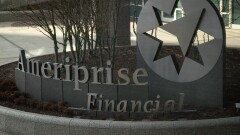Three years to the day after the SEC's
The sampling below of disclosures from Ameriprise, LPL Financial, UBS, Morgan Stanley, Edward Jones, Merrill, Osaic (
Mutual fund managers, whose products the firms' financial advisors recommend, pay wealth management companies a portion of their profits or revenue that the firms often refer to as "marketing" or "partner" fees. The amount of the revenue-sharing payments usually stems from the level of assets invested in the fund companies' products. As shown by the companies' disclosures, the money can add up to hundreds of millions of dollars or more in added revenue each year for the largest wealth management firms.
Those payments have "largely replaced" a different stream of money flowing between product sponsors and wealth managers called 12b-1 fees, which are known as "distribution" costs, according to Micah Hauptman, the director of investor protection at the nonprofit
"These arrangements are often opaque and difficult to understand," he said. "Revenue sharing is often used by funds to encourage and reward broker-dealers and investment advisers and their reps to recommend certain funds over others. In other words, revenue sharing can influence financial professionals to recommend products based on factors other than their clients' or customers' best interests. It is unlikely that disclosure alone will adequately address this conflict of interest."
Hauptman praised the Securities and Exchange Commission's "important enforcement actions" against some firms
Asked about the wide differences in the details shared on the firms' websites and in other disclosures, representatives for the SEC declined to comment. The regulator's
"When there is a conflict created by firms or their financial professionals receiving compensation from third parties, whether or not sales-related (including, but not limited to, revenue sharing, sub-accounting, administrative services fees paid by a fund or its advisor), in the staff's view, broker-dealers, investment advisors or their financial professionals should disclose the existence and effects of such incentives provided to the firm or shared between the firm and others," according to an SEC
In the wake of that guidance, certain firms are providing much more detail than others to advisors, clients and the public about their relationships with mutual fund companies. Ameriprise and Edward Jones are the only firms that displayed the exact amount of the revenue sharing payments they received on their website. In contrast, the page of UBS didn't show a listing of the companies participating in the firms' revenue sharing programs.
Scroll down the slideshow for some of the most interesting information about revenue sharing at 10 of the largest wealth management firms. To see coverage of SEC guidance about firms' conflicts of interest obligations under Regulation Best Interest,
Note: The information below came from the companies' available disclosures through their websites, earnings reports and regulatory disclosures, as well as inquiries to each of the firms. The links to each of the documents referenced below contain their full language and available numbers, as of June 30, 2023.

















